Zygomycetes(Gr. zygos= yoke; spora= seed, spore) are a variant fungal class of the phylum Zygomycota, mostly known as “Pin Molds”, can be found worldwide. There are 450 species which are grouped under 70 genera that make up the class Zygomycetes.
The class zygomycetes is named after the thick-walled resting spores which is called zygospores and these are formed in consequence of the complete fusion of the protoplasts of two equal or unequal gametangia. However, because not all species placed in this class have been shown to produce zygospores, a variety of morphological, biological and ecological characteristics also enter into defining the class.
Best safe and secure cloud storage with password protection
Get Envato Elements, Prime Video, Hotstar and Netflix For Free
Best Money Earning Website 100$ Day
#1 Top ranking article submission website
General characteristics
- Zygomycetes are unique fungi because they possess the capability to reproduce both sexually, by creating zygospores, and asexually.
- The principal characteristic of this class is the production of a thick-walled resting spore called a zygospore by a process of conjugation.
- The zygospore develops within the zygosporangium that is formed after fusion of two gametangia.
- Asexual reproduction by means of sporangiospores produce within the sporangium on the sporangiophore (Except Entomophthorales order– by conidia).
- Complete absence of motile cells in the whole life cycle.
- Presence of developed coenocytic mycelium (lack of regular septation).
- Cell wall composed of chitin, chitosan and polyglucuronic acid.
Order – Mucorales
Mucorales has by far the largest number of species and morphological diversity of the seven orders of Zygomycetes. Because of the members of this order zygomycetes is called pin molds.
Mucorales can be separated from the other orders of Zygomycetes by a combination of their asexual and sexual reproductive structures as well as by their relatively non-specialised associations with other organisms. The difference will become readily apparent.
Somatic structure
- Well-developed coenocytic mycelium.
- Mycelium is dense, cottony growth on the surface of the substratum.
- Hyphal septa usually produced only at the base of reproductive organ viz., sporangia or gametangia or old or injured hyphae.
- Septa are solid plates.
- In some species, rhizoid formed at the point of the mycelium where contacts a hard surface.
- The rhizoids adhere to the substrate and anchor the fungus securely and take nutrients.
- The intervening hypha (connecting two groups of rhizoids) called stolon present that resembles the runner of a strawberry plant (Example– Rhizopus stolonifer).
Habitat
- Mostly saprobic that occurs in dung, soil, humus and other organic debris.
- Weakly parasites on plants.
- Endoparasites in vertebrates including human.
Asexual reproduction
- Asexual reproduction by means of non-motile sporangiospores produces within the globose or pear-shaped sporangia.
- The sporangia may be borne solely (eg. Mucor, Rhizopus) at the tip of a sporangiophore or on a branched sporangiophore (eg. Actinomucor elegans).
Sporangiola: Reduced or much smaller sporangia, lack of columella.
Merosporangia: Elongated rod-like sporangiola.
Different types of asexual structures of Mucorales order
Mucor: Sporangia borne singly at the tip of a sporangiophore. Numerous sporangiospore and columella present. Absence of stolon.
Rhizopus stolonifer: Sporangia borne singly at the tip of a sporangiophore. Numerous sporangiospore and columella present. Presence of stolon.
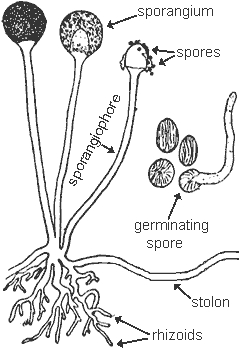
Actinomucor elegans: Sporangia borne singly at the terminal and lateral branches of sporangiophore. Columella present.
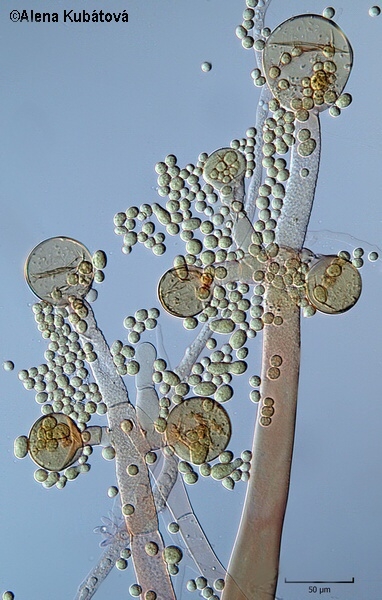
Thamnidium elegans: Sporangia with columella produce on the terminal sporangiophore and sporangiola (non-columellate) produce on the dichotomously branched lateral sporangiophore.
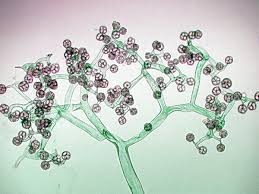
Choanephora trispora: Sporangiophore with swellon tips and each sporangiole bears three spores.
Syncephalastrum racemosum: Sporangiophores bearing a vesicle and numerousm merosporangia Presence of 5 to 10 merospores within the merosporangia.
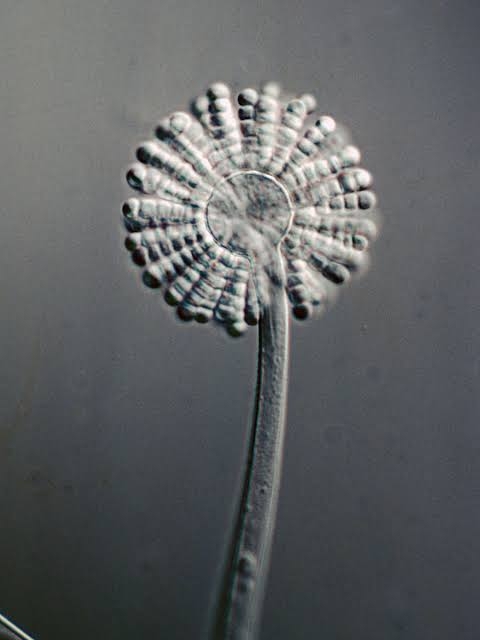
Coemansia mojavensis: Sporangiophores bear numerous sporocladia. Each sporocladium bears many monosporous merosporangium.
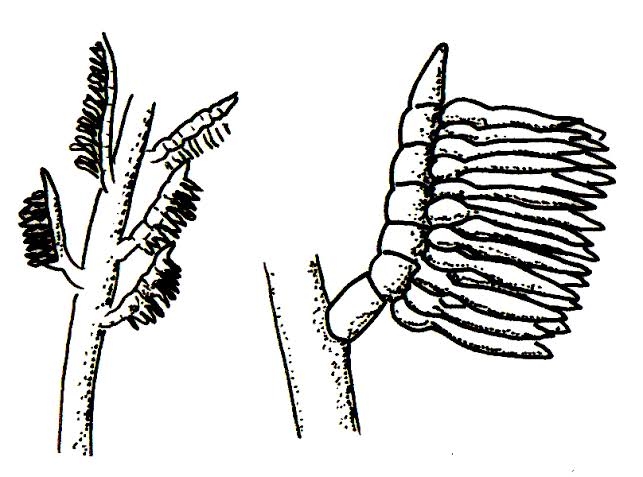
Cunninghamella elegans: At the tip of sporangiophore vesicle present. Vesicle bears pedicellate unispored sporagiola.

Sexual reproduction
- Member of Mucorales are both homothallic and heterothallic that produce zygospores.
- Zygospore produced by the fusion of two multinucleate gametangia.
Production of zygospore by heterothallic Rhizopus stolonifer
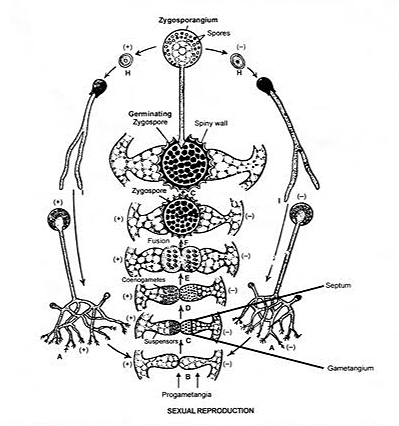
Production of zygospore by homothallic Rhizopus sexualis
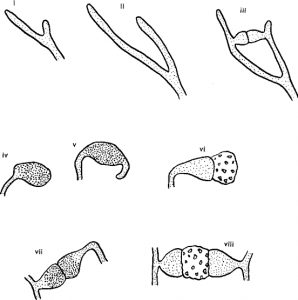
Life cycle of Rhizopus stolonifer
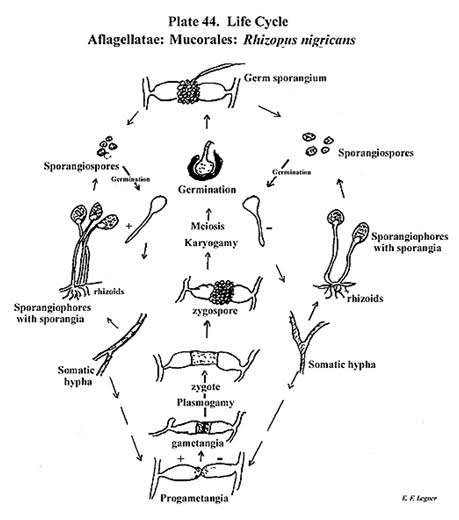
Harmful effects of the members of Mucorales
Several species of Mucor, Rhizopus and Absidia cause diseases in human which known as muromycosis.
1. Mucor racemosus: Causes storage rots of wide variety of fruits and vegetables.
2. Rhizopus stolonifer: It is known as “Black Bread Mold” because it grows on moist, old bread. It causes destructive diseases on strawberries during shipping and marketing. It also damages sweet potatoes during storage, causing a soft rot condition. Bud rot of jackfruit.
3. Absidia corymbifera and several species of Mucor & Rhizopus: Attack human’s nervous system with fatal consequences.
Uses of the members of the Mucorales
1. Rhizopus sinensis, Rhizopus stolonifer, Rhizopus nodosus– Capable of forming fumaric acid, lactic acid, citric acid, succinic acid and oxalic acid.
2. Rhizopus oryzae– Use for the production of wine.
References
This Article is completely based on by the lecture of Sorwar Hossain, Lecturer, Department of Botany, University of Dhaka.
Author has added Some info and pictures.
- Introduction To Mycology by Alexopoulos.
 Plantlet The Blogging Platform of Department of Botany, University of Dhaka
Plantlet The Blogging Platform of Department of Botany, University of Dhaka
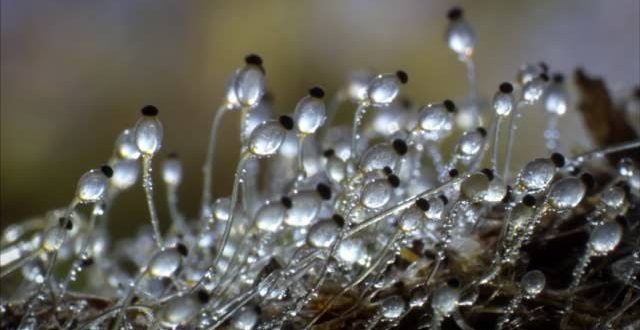


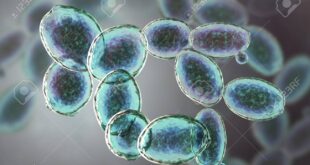
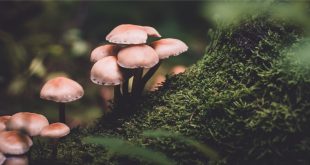
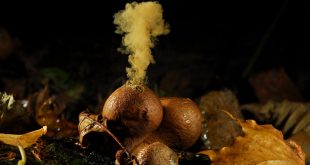
Very much Impressive!! Nice to read. Keep it up man.
It’s a really good piece of information.
Thank you for your sharing. I am worried that I lack creative ideas. It is your article that makes me full of hope. Thank you. But, I have a question, can you help me?